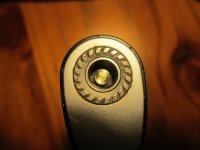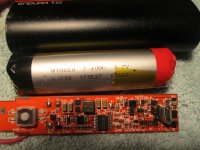Depends... sitting that long you may have to "prime it". No joke, this works if anything does. Need to get access to individual cells. Can probably just stick dressmakers pin through shrink wrapping to access center point. Then take a fully charged 18650 and hook it paralell to each cell for about 10 seconds. Each! Positive to positive, negative to negative. Do not hook up backwards! Do not leave hooked together for longer. Put on charger after priming. Then check it again. Report your results.
Doc (Thus I assumed you were asking me...).
Doc (Thus I assumed you were asking me...).
7,2v = 3.6 x 2 in series. That means cells are connected together in middle, the positive of one cell connected to negative of other. 7.2 volts will actually be a minimum voltage. Full chare on each cell is 4.3 volts making possible max voltage of 8.6 volts. So to prime cell that has negative connected to output wire, you must connect a positive lead where two celks are connected together. Like so
Minus wire of pack--------| |++++X--------| |++++++ plus wire of pack The X in middle is center point.
Doc
Minus wire of pack--------| |++++X--------| |++++++ plus wire of pack The X in middle is center point.
Doc
I had a flat pack single cell camera battery that went like that.
I set my bench power supply to about 4.5 volts and turned the current limit down to about 100ma and dabbed it on for a couple of seconds.
It then triggered the charger and took a full charge.
Good battery chargers test the battery before starting to charge it.
I set my bench power supply to about 4.5 volts and turned the current limit down to about 100ma and dabbed it on for a couple of seconds.
It then triggered the charger and took a full charge.
Good battery chargers test the battery before starting to charge it.
I had a flat pack single cell camera battery that went like that.
I set my bench power supply to about 4.5 volts and turned the current limit down to about 100ma and dabbed it on for a couple of seconds.
It then triggered the charger and took a full charge.
Good battery chargers test the battery before starting to charge it.
This battery has a 3 wire input, red, black and white. The output is 2 wires red and black. So I take it I will zap it through the input red and black wires to be sure?
Some cells even single ones have a FET inside them that shuts the output off if they become discharged that can also cut off the charging voltage at the end of charging like an electronic cigarette.
I've got it charging now, I zapped it through the inputs with a 9v battery for about 2 seconds then tried it in the charger and the red light flickered (it didn't do that before?) so I checked to see if it was charging with a DMM and it is charging at 8.46v. Thanks for the info fellas it saved this battery from a landfill.
Now I've got a vape that consists of 2 x 18650 batteries, it won't charge but I can't figure out how to kick start it? The anode is pushed down to make the connection when the top is screwed onto the batteries. I've pushed down with the positive probe of my Multimeter and grounded the black probe to the edge of the hole with no results? Any ideas on how would I get around this one?
Attachments
I would first put it on the charger and turn on and off with about 30 seconds on and off timing for about 5 or 6 times.
The start up test usually applies voltage for a short time and once the little test bursts have added a little bit of charge the charger detects a valid battery and begins charging.
This works for some types of camera battery.
The start up test usually applies voltage for a short time and once the little test bursts have added a little bit of charge the charger detects a valid battery and begins charging.
This works for some types of camera battery.
That didn't work either so I took it apart and found that it was fully charged to just over 4v? It doesn't appear to be lighting the coil when the button is pushed so it might have water in the momentary-on switch? So I'm drying that out now. I can see a bit of fog under the plastic coating on the PCB looking through a jeweler loupe so it looks like a hairdryer job. I'm wary of these Lithium batteries so I will be heating it up carefully bit by bit. I'm surprised at how sophisticated the PCB board is on these things?
Attachments
I design lithium ion battery packs for consumer electronics for a living and all I can say is you guys are nuts.. (Said in the kindest way possible) The 18650 when abused is dangerous.
I sure would not want damaged cells in a vape pen I was sticking in my mouth. Burning RC controlled toys are bad enough...
Damaged cells when recharged can become extremely hazardous if there is any mechanical damage due to misuse or excessive discharging - they can develop internal shorts across the separator and when that happens they become violently exothermic - we've all seen the videos.
The mosfets discussed are on a PCBA separate from the cells themselves and can only protect cells from external abuse, and not from an internal cell failure due to ill-advised tinkering once the electronics have deemed the pack unsafe for use. (Not all pack electronics is sophisticated enough to permanently disable the battery pack in the event of a fault.)
This thread discusses unsafe practices which could injure the unwary.
I sure would not want damaged cells in a vape pen I was sticking in my mouth. Burning RC controlled toys are bad enough...
Damaged cells when recharged can become extremely hazardous if there is any mechanical damage due to misuse or excessive discharging - they can develop internal shorts across the separator and when that happens they become violently exothermic - we've all seen the videos.
The mosfets discussed are on a PCBA separate from the cells themselves and can only protect cells from external abuse, and not from an internal cell failure due to ill-advised tinkering once the electronics have deemed the pack unsafe for use. (Not all pack electronics is sophisticated enough to permanently disable the battery pack in the event of a fault.)
This thread discusses unsafe practices which could injure the unwary.
- Status
- Not open for further replies.
- Home
- General Interest
- Everything Else
- 18650 battery pack diagnosis.


 Closed by moderation for safety reasons.
Closed by moderation for safety reasons.